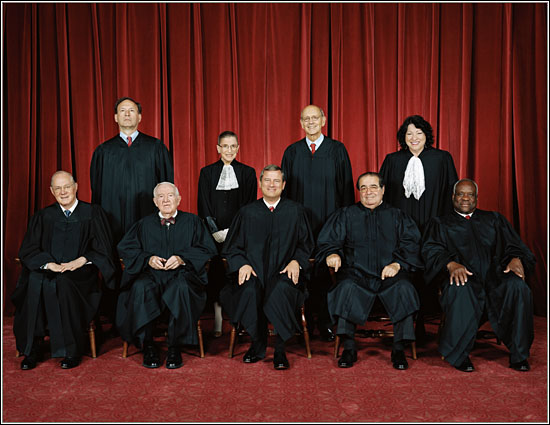Know Your Supreme Court Justices ? Most Americans Don’t
According to a new poll, two-thirds of Americans can’t name a single member of the U.S. Supreme Court:
EAGAN, Minn., June 1 /PRNewswire/ — Nearly two-thirds of Americans cannot name any members of the U.S. Supreme Court, according to a new national survey by FindLaw.com (http://www.findlaw.com), the most popular legal information website. Even as Supreme Court nominee Elena Kagan awaits Senate confirmation hearings to replace retiring justice John Paul Stevens, only 35 percent of Americans can name even one member of the nation’s highest court.
Clarence Thomas is the most well known justice but could be named by only 19 percent of Americans. Chief Justice John Roberts was named by 16 percent of people. Sonia Sotomayor, the newest justice, could be named by only 15 percent of Americans following a highly visible nomination and confirmation process last year.
According to the FindLaw.com survey, the percentages of Americans who can name any U.S. Supreme Court justices are:
- Clarence Thomas — 19%
- John Roberts — 16%
- Sonia Sotomayor — 15%
- Ruth Bader Ginsburg — 13%
- Antonin Scalia — 10%
- Samuel Alito — 8%
- John Paul Stevens — 8%
- Anthony Kennedy — 6%
- Stephen Breyer — 3%
Only 1 percent of Americans could correctly name all nine current members of the Supreme Court.
In addition, many Americans think that retired justices Sandra Day O’Connor and David Souter are still active members of the Supreme Court. O’Connor and Souter retired from the Court in 2006 and 2009, respectively.
This isn’t entirely surprising, of course. Outside of confirmation hearings, Supreme Court Justices do their work outside the view of the public and even when a controversial or highly publicized decision is issued, it comes from a collective body and is communicated by reporters rather than the Justices themselves. Unlike, say, people who don’t have enough awareness of politics to identity their Federal or state representatives, the fact that large numbers of Americans don’t know who Stephen Breyer or Anthony Kennedy might be is neither surprising or concerning. One imagines that these numbers would change, though, if the Court ever did accept the long-discussed idea of cameras in the courtroom.
The rankings above are interesting in themselves. Twenty years after the most sensational and controversial confirmation hearings in history, even Clarence Thomas has faded into virtual anonymity to the point where he’s able to spend his summers traveling around the country in an RV without most people realizing who he might be. One does have to feel a little sorry for Stephen Breyer, though, when you see that 97% of the people polled have no idea who he is.
And for the record, in the photo above it’s Samuel Alito, Ruth Bader Ginsburg, Stephen Breyer, and Sonia Sotomayor (Back row left to right) and Anthony Kennedy, John Paul Stevens, John Roberts, Antonin Scalia, and Clarence Thomas (Front row left to right). See ? Now you’re smarter than 67% of the American public.
H/T: Steve Benen

I can name all of them, but then I have sort of been a SCOTUS junkie since I graduated from college 20 years ago.
I think in general school’s will focus on court issues, but not necessarily who is on the court, and I figure most people don’t really pay attention to court rulings unless they are big ones.
One could even argue that this is a good thing, in that it means individual Justices are keeping out of the spotlight. The legitimacy of the Court has always depended on maintaining a mystique that it’s an apolitical body of oracles.
Good point and also a possible argument against cameras in the SCOTUS courtroom.
Used to be we could say “a bunch of old white guys?” and not be far wrong.
(I get all my Supreme Court news from Saturday Night Live.)
I’ll second the ‘good point’ to James’ comment.
I gave myself about a minute and could only name six.
I wonder why Stephen Breyer has the lowest score? What’s so forgettable about him? When I tried to name them all, I could name all but Breyer as well….
I’d be surprised if anyone who comments here cannot name all nine justices, and the last three that retired.
This bothers me quit a bit as it helps reinforce perception over reality, yet again. They have a specific function dictated by the US Constitution and tradition established over hundreds of years. Sunlight and transparency are what is needed, not mysticism, not outrageous suppositions that they are apolitical, nor that they are oracular in any sense of the word.
I’m in the odd position of agreeing with Charles. We could do with some demystification of the court as well as the presidency.
These are all our employees. We should understand that they have difficult jobs and cut them appropriate slack. But we should not turn them into heros, champions, oracles, mother-substitutes, father-substitutes or anything else. (I particularly have in mind the national cry for more emotional posturing from the president.)
The idea that putting on a black robe turns a man or woman into some avatar of perfect rationality and objectivity is superstition.
I was able to name 5-6 without cheating and just off the top of my head, but am prone to tripping over souter and connor since I’m so used to them being there.